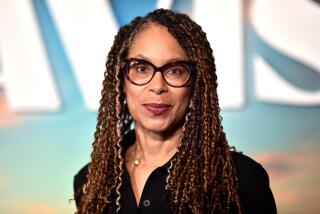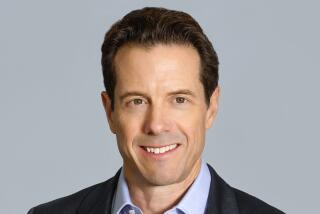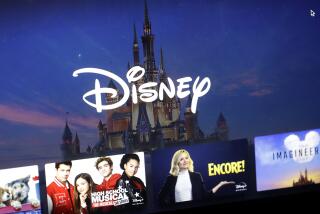Disney takes tighter control of Hulu
As the workday wound to a close Friday evening, employees from Hulu flocked to local watering holes across Santa Monica to toast the end of an era. Some were thrilled. Some fought back tears. But they all accepted that Hulu’s days as a stand-alone operation were over.
Earlier that day, Walt Disney Co. had announced that Hulu Chief Executive Randy Freer would depart in the coming weeks and that the people under him would now report to Disney managers. The world’s largest entertainment company is tightening its grip on Hulu after the successful launch of Disney+ in November and a push to sell all its streaming services in a single discounted bundle.
Further punctuating Hulu’s ambitions: a Super Bowl ad with NFL star Tom Brady saying, “It’s time to say goodbye to TV as you know it.”
Hulu’s domestic subscriptions rose sharply in the final two months of 2019, fueled by a package that included both Disney+ and ESPN+ for a total of $13 a month. Disney’s bundling of the three services accounted for a significant share of Hulu sign-ups in 2019, according to Antenna Analytics, a research firm that measures subscriber data for streaming companies.
The gains helped Hulu grow twice as fast as Netflix in the United States last year, with the service easily surpassing 30 million total subscribers, according to people with knowledge of the numbers. In the last publicly reported numbers, Disney said Hulu had 28.5 million customers at the end of September.
“It’s been on an awesome growth trajectory,” Rameez Tase, Antenna’s chief executive, said of Hulu.
Disney will give investors an update on the performance of its streaming efforts Tuesday, in its first quarterly report since the company began selling the Disney+ family-focused service. CEO Bob Iger will tout the growth of that service and the popular Baby Yoda character it has spawned, but he also will update investors on Hulu.
Hulu is a key part of Iger’s three-pronged approach to streaming, providing more grown-up fare to complement Disney’s family and sports offerings. In March, Hulu will add hit shows from the catalog of Disney’s FX Networks and release original series produced by that cable TV outlet. At the same time, the service is reducing what it buys from outside the Disney family.
Online pioneer
Hulu began life in 2007 as a way for NBC and Fox to attract online viewers for their shows after those programs aired on their networks. Disney bought in a couple of years later, and that clarity of purpose evaporated as the three owners and management fought over the service’s direction. Was it a place to watch reruns or original programming? Should it be free or paid? Should it support cable TV or fight it?
As recently as 2013, the owners were looking to get out, putting Hulu up for sale in a process that ultimately faltered. When Netflix eclipsed 100 million worldwide customers in 2017, Hulu had yet to hit 20 million.
Last year, Disney completed deals that gave it operational control over Hulu, along with an agreement to buy out the last outside shareholder, Comcast Corp., by 2024.
“The challenge with Hulu has historically been the fragmented-parent thing and how that has been in terms of finding its own way,” said Stephen Beck, founder and managing partner at CG42, a New York consulting firm whose clients have included AT&T Inc. and Microsoft Corp. “We see that improving with how it’s structured now.”
‘The Handmaid’s Tale’
Growth at Hulu soared after the debut of its first original hit in 2017. “The Handmaid’s Tale,” an adaptation of Margaret Atwood’s novel about a dystopian future, remains the most popular program on the service, followed by “Castle Rock,” according to independent research firm MoffettNathanson.
But just 15 of the top 100 Hulu shows are originals, the analysts said, far fewer than Netflix or Amazon Prime, despite the company working with George Clooney, Jeff Daniels and Stephen King. Hulu has yet to release a show that matches “Handmaid’s Tale” in popularity or cultural impact, though it has projects that critics love, including the comedies “Ramy” and “Shrill.”
“We’ve built a strong pipeline for these kinds of projects,” Craig Erwich, Hulu’s chief of original programming, said at the Television Critics Assn.’s winter press previews last month. “Aligning more closely within the Walt Disney company has powerfully bolstered this strategy.”
In the coming months, for example, FX will create original shows for the service, such as “Mrs. America,” a miniseries featuring Cate Blanchett as 1970s conservative activist Phyllis Schlafly; it premieres in April.
Red ink
Hulu still faces numerous challenges, including a probably still-bumpy integration with Disney. Skeptics such as Cowen & Co. analyst Doug Creutz say the business is still losing a lot of money, and Disney has yet to prove it can produce hits consistently outside of its core family-focused properties.
“This is just another ABC,” he said, comparing Hulu to the Disney-owned broadcast network that’s in last place in the Nielsen ratings.
What’s more, the discounting that has driven subscriber growth won’t last forever, and Hulu will learn soon how many of its customers stick around when they have to pay a higher price. Netflix blamed its sluggish U.S. subscriber growth in 2019 partly on a price increase.
Disney has said it expects Hulu to become profitable in three to four years, at which point it could have 60 million subscribers worldwide.
Tighter grip
Kevin Mayer, Iger’s top lieutenant, met with Freer’s senior management team Friday afternoon after the announcement of Freer’s departure. Mayer may appoint a general manager of Hulu, but he and Iger will have a more direct influence on Hulu’s operations.
As part of the changes announced last week, Disney will take over functions such as finance, human resources and public relations. Hulu’s original-programming team was already reporting to Dana Walden, the head of Disney’s TV studios.
Hulu’s technology team will be combined with Disney Streaming Services, formerly BAMTech, which runs Disney’s streaming business. Hulu currently employs more engineers than entertainment executives, in contrast with Disney, and competes with top technology companies for new hires. Its employees identify as “Hulugans.”
Over the longer term, Disney sees benefits that will outweigh whatever short-term pain Hulu experiences. Existing TV networks benefit from an online outlet to reach young viewers who no longer watch cable or satellite.
Tom Ascheim, president of Disney’s young-adult-focused Freeform network, told journalists last month that two-thirds of the online viewers for his original programs come from Hulu.
“Boy, it’s nice to have them in the family,” he said.
Shaw and Palmeri write for Bloomberg.
More to Read
Inside the business of entertainment
The Wide Shot brings you news, analysis and insights on everything from streaming wars to production — and what it all means for the future.
You may occasionally receive promotional content from the Los Angeles Times.










